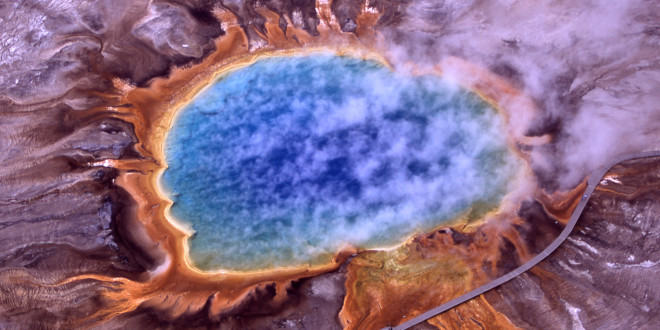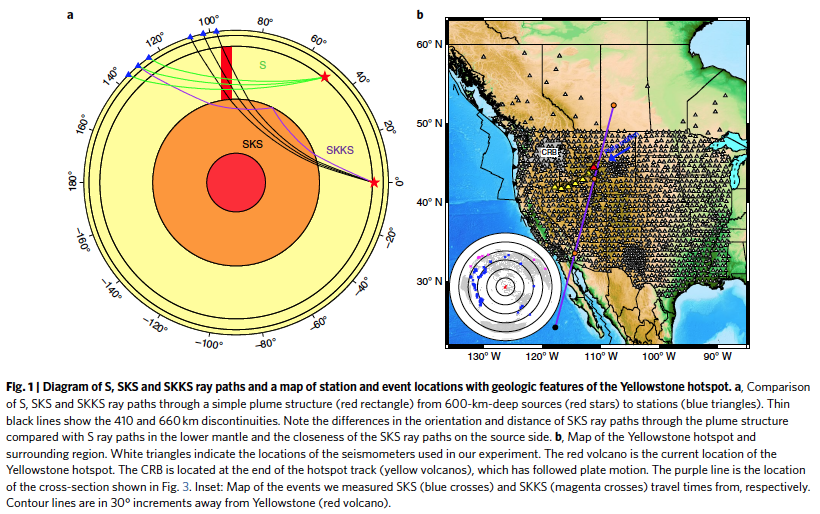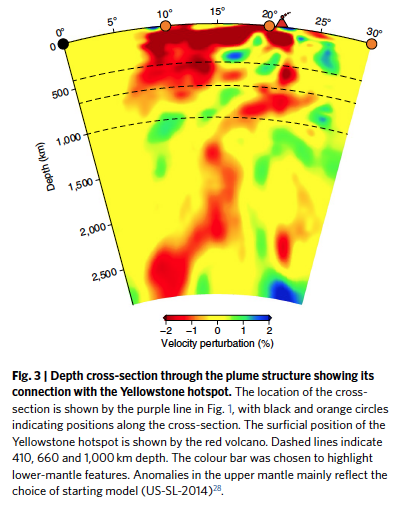New research suggests Yellowstone National Park’s thermal heat could come from deeper in the earth than previously supposed.
In a new paper published in Nature Geoscience today, researchers Peter Nelson and Stephen Grand from the Jackson School of Geosciences at the University of Texas at Austin propose that Yellowstone’s heat source could come from a plume extending from the core-mantle boundary (CMB). Further, this potential plume could be situated in a zone of material that runs from Mexico all the way to the park.
Nelson is a graduate student in the Jackson School, while Grand is the Carleton Professor of Geophysics. You can read the pair’s paper here.
To conduct their research, Nelson and Grand analyzed seismic data from EarthScope’s USArray, which has stations all across North America. According to a Nature press release, looking at a continental scale, the pair identified “a long, thin, sloping zone within the mantle through which seismic waves travel more slowly—and which may indicate the presence of unusually warm material.” You can see a diagram of this zone below, courtesy of Nature Geoscience.
The paper provides a brief overview of the Yellowstone plume theory, which has been hotly contested since it was first proposed. Broadly speaking, the plume theory holds that Yellowstone’s heat (and, hence, its geysers and hot springs) comes from magma rising from within the earth upward toward the crust.
According to research from the University of Utah, that magma feeds into a pair of reservoir below Yellowstone’s surface, brimming with enough material to fill the Grand Canyon of Arizona nearly 14 times over. Below, you can see a cross section of the Yellowstone plume, courtesy of Nelson, Grand, and Nature Geoscience.
Part of the reason this theory has been so contested when it comes to Yellowstone, according to Nelson and Grand, is that Yellowstone “has features not in accord with classical plume theory.” For instance, Yellowstone has more than one hotspot track. Then there’s the matter of the rock surrounding this plume. The Nelson and Grand paper references research from Tiffany Leonard and Lijun Liu of the University of Illinois at Urbana-Champaign, who argue that a tectonic plate above the Yellowstone plume limits its activity and influence on Yellowstone.
Liu (along with graduate students Jiashun Hu and Quan Zhou) published a paper earlier this year in Nature arguing that Yellowstone’s heat is “funneled” from the Pacific Coast, a point contested by researchers at the University of Utah.
Part of the reason plume theory is so hard to prove, according to Nelson and Grand, is because plumes are difficult to track using traditional methods. Seismographs and other geological equipment track two basic movement types in the Earth: primary waves and secondary/shear waves. P waves can travel through any material while S waves only travel through solids. In theory, they should stop in the presence of plumes, since they consist of superheated, viscous rock. However, plumes aren’t liquid enough to stop S waves, though they do impede them.
In their paper, the pair concludes that “a plume rising from the CMB is the ultimate heat source driving Yellowstone volcanism.” The pair add, however, that further research is needed into why Yellowstone exists where it does. The pair suggests the Yellowstone plume could be held in place by a piece of the Pacific large low-shear-velocity province (or superplume). Another hypothesis is that Yellowstone’s plume is “purely thermal,” generating from the CMB.
Finally, the pair conclude that current global tomography (creating cross sections of solid objects using X-rays or ultrasound) models can’t capture “thin thermal plumes” like the on beneath Yellowstone adequately. They offer their research as a model for further studies.
 Yellowstone Insider Your Complete Guide to America's First National Park
Yellowstone Insider Your Complete Guide to America's First National Park








You must be logged in to post a comment.